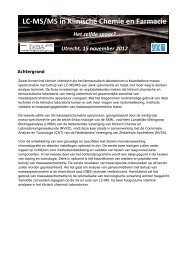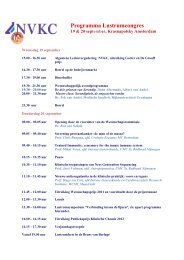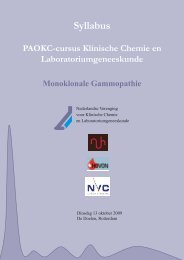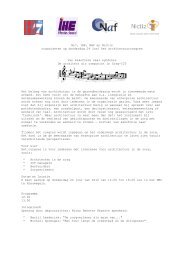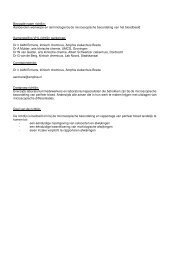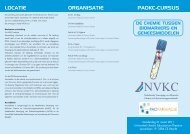Post Academisch Onderwijs in de Klinische Chemie PAOKC - NVKC
Post Academisch Onderwijs in de Klinische Chemie PAOKC - NVKC
Post Academisch Onderwijs in de Klinische Chemie PAOKC - NVKC
You also want an ePaper? Increase the reach of your titles
YUMPU automatically turns print PDFs into web optimized ePapers that Google loves.
<strong>PAOKC</strong>: A gui<strong>de</strong> to better sli<strong>de</strong>s 7<br />
Text sli<strong>de</strong>s<br />
maximum 6 words <strong>in</strong> the title<br />
no more<br />
than<br />
7<br />
l<strong>in</strong>es<br />
<strong>in</strong> height<br />
no more than 7 words <strong>in</strong> width<br />
TITLE<br />
1. statement<br />
TITLE<br />
1. statement<br />
2. statement<br />
TITLE<br />
1. statement<br />
2. statement<br />
3. statement<br />
Text sli<strong>de</strong>s are appropriate for <strong>in</strong>troduc<strong>in</strong>g the objectives of a study, for <strong>de</strong>f<strong>in</strong>itions or quotations and for the summary of<br />
conclusions. Limit the number of words and l<strong>in</strong>es. Progressive disclosure of a text sli<strong>de</strong>, statement by statement, allows<br />
synchronization of verbal and visual presentation and will often optimize the net effect of the audiovisual communication<br />
between a lecturer and his audience. The presentation of such a “statement by statement” sequence of sli<strong>de</strong>s takes no<br />
more time than would otherwise be required for the audience to read (and un<strong>de</strong>rstand) the complete text from a s<strong>in</strong>gle<br />
sli<strong>de</strong>.<br />
Tables<br />
no more than 4 columns<br />
no more<br />
than<br />
7<br />
l<strong>in</strong>es<br />
<strong>in</strong><br />
height<br />
Limit the number of columns and l<strong>in</strong>es. Only data relevant to the subject of your paper should be <strong>in</strong>clu<strong>de</strong>d. State<br />
significance when possible and reasonable, either by asterisks or by <strong>in</strong>dicat<strong>in</strong>g p-values <strong>in</strong> a separate column.<br />
Number of sli<strong>de</strong>s / amount of text<br />
The manuscript for a 10 m<strong>in</strong>utes address should not exceed four A4 pages or double-space typ<strong>in</strong>g. The number of<br />
accompany<strong>in</strong>g sli<strong>de</strong>s should not exceed eight. For repetition of a sli<strong>de</strong> use duplicates. A duplicate only serves as a<br />
rem<strong>in</strong><strong>de</strong>r and its presentation usually <strong>de</strong>mands little or no extra time. Avoid the use of more than one sli<strong>de</strong> per m<strong>in</strong>ute.<br />
Simultaneous projection of two sli<strong>de</strong>s<br />
Parallel projection by two projectors is a technique suited for purposes of comparison. It is most effective when one or<br />
both of the sli<strong>de</strong>s is entirely pictorial, but it may be used to <strong>in</strong>troduce new data or a text sli<strong>de</strong> while reta<strong>in</strong><strong>in</strong>g its<br />
pre<strong>de</strong>cessor. Do not use two simultaneous sli<strong>de</strong>s full of text or data just to double the amount of <strong>in</strong>formation you can get<br />
on the screen. Match your sli<strong>de</strong>s <strong>in</strong> pairs for simultaneous presentation and place <strong>in</strong> two magaz<strong>in</strong>es, one magaz<strong>in</strong>e for<br />
each projector. Use duplicates to reta<strong>in</strong> a picture from one comparison to the next. Inclu<strong>de</strong> a dark sli<strong>de</strong> <strong>in</strong> the other<br />
magaz<strong>in</strong>e when only one sli<strong>de</strong> is to be projected. Then the projectionist only has to advance both magaz<strong>in</strong>es<br />
simultaneously and the sli<strong>de</strong> presentation will proceed with automatic shifts between s<strong>in</strong>gle and double projections.







